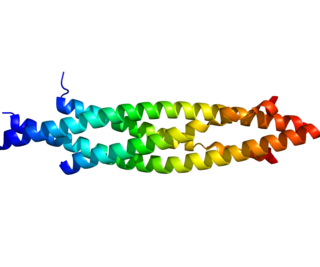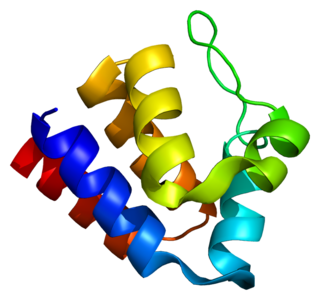Pattern recognition receptors (PRRs) play a crucial role in the proper function of the innate immune system. PRRs are germline-encoded host sensors, which detect molecules typical for the pathogens. They are proteins expressed mainly by cells of the innate immune system, such as dendritic cells, macrophages, monocytes, neutrophils, as well as by epithelial cells, to identify two classes of molecules: pathogen-associated molecular patterns (PAMPs), which are associated with microbial pathogens, and damage-associated molecular patterns (DAMPs), which are associated with components of host's cells that are released during cell damage or death. They are also called primitive pattern recognition receptors because they evolved before other parts of the immune system, particularly before adaptive immunity. PRRs also mediate the initiation of antigen-specific adaptive immune response and release of inflammatory cytokines.

Myeloid differentiation primary response 88 (MYD88) is a protein that, in humans, is encoded by the MYD88 gene. originally discovered in the laboratory of Dan A. Liebermann as a Myeloid differentiation primary response gene.

Muramyl dipeptide is a component of bacterial peptidoglycan, a recognition structure or activator for nucleotide-binding oligomerization domain 2 (NOD2) protein. It is a constituent of both Gram-positive and Gram-negative bacteria composed of N-acetylmuramic acid linked by its lactic acid moiety to the N-terminus of an L-alanine D-isoglutamine dipeptide. It can be recognized by the immune system as a pathogen-associated molecular pattern and activate the NALP3 inflammasome which, in turn, leads to cytokine activation, IL-1α and IL-1β especially.

NF-kappa-B essential modulator (NEMO) also known as inhibitor of nuclear factor kappa-B kinase subunit gamma (IKK-γ) is a protein that in humans is encoded by the IKBKG gene. NEMO is a subunit of the IκB kinase complex that activates NF-κB. The human gene for IKBKG is located on the chromosome band Xq28. Multiple transcript variants encoding different isoforms have been found for this gene.

Nucleotide-binding oligomerization domain-containing protein 2 (NOD2), also known as caspase recruitment domain-containing protein 15 (CARD15) or inflammatory bowel disease protein 1 (IBD1), is a protein that in humans is encoded by the NOD2 gene located on chromosome 16. NOD2 plays an important role in the immune system. It recognizes bacterial molecules (peptidoglycans) and stimulates an immune reaction.

IKK-β also known as inhibitor of nuclear factor kappa-B kinase subunit beta is a protein that in humans is encoded by the IKBKB gene.

TNF receptor-associated factor 5 is a protein that in humans is encoded by the TRAF5 gene.

TNF receptor-associated factor (TRAF3) is a protein that in humans is encoded by the TRAF3 gene.

B-cell lymphoma/leukemia 10 is a protein that in humans is encoded by the BCL10 gene. Like BCL2, BCL3, BCL5, BCL6, BCL7A, and BCL9, it has clinical significance in lymphoma.

Receptor-interacting serine/threonine-protein kinase 1 (RIPK1) functions in a variety of cellular pathways related to both cell survival and death. In terms of cell death, RIPK1 plays a role in apoptosis, necroptosis, and PANoptosis Some of the cell survival pathways RIPK1 participates in include NF-κB, Akt, and JNK.

PYCARD, often referred to as ASC, is a protein that in humans is encoded by the PYCARD gene. It is localized mainly in the nucleus of monocytes and macrophages. In case of pathogen infection, however, it relocalizes rapidly to the cytoplasm, perinuclear space, endoplasmic reticulum and mitochondria and it is a key adaptor protein in activation of the inflammasome.

Receptor-interacting serine/threonine-protein kinase 2 is an enzyme that in humans is encoded by the RIPK2 gene.

TBK1 is an enzyme with kinase activity. Specifically, it is a serine / threonine protein kinase. It is encoded by the TBK1 gene in humans. This kinase is mainly known for its role in innate immunity antiviral response. However, TBK1 also regulates cell proliferation, apoptosis, autophagy, and anti-tumor immunity. Insufficient regulation of TBK1 activity leads to autoimmune, neurodegenerative diseases or tumorigenesis.

TNF receptor-associated factor 4 (TRAF4) also known as RING finger protein 83 (RNF83) is a protein that in humans is encoded by the TRAF4 gene.

NACHT, LRR and PYD domains-containing protein 2 is a protein that in humans is encoded by the NLRP2 gene.

Nucleotide-binding oligomerization domain-like receptor (NLR) pyrin domain (PYD)-containing protein 12 is a protein that in humans is encoded by the NLRP12 gene.

The nucleotide-binding oligomerization domain-like receptors, or NOD-like receptors (NLRs), are intracellular sensors of pathogen-associated molecular patterns (PAMPs) that enter the cell via phagocytosis or pores, and damage-associated molecular patterns (DAMPs) that are associated with cell stress. They are types of pattern recognition receptors (PRRs), and play key roles in the regulation of innate immune response. NLRs can cooperate with toll-like receptors (TLRs) and regulate inflammatory and apoptotic response.

NLRC5, short for NOD-like receptor family CARD domain containing 5, is an intracellular protein that plays a role in the immune system. NLRC5 is a pattern recognition receptor implicated in innate immunity to viruses potentially by regulating interferon activity. It also acts as an innate immune sensor to drive inflammatory cell death, PANoptosis. In humans, the NLRC5 protein is encoded by the NLRC5 gene. It has also been called NOD27, NOD4, and CLR16.1.

NOD-like receptor family pyrin domain containing 11 is a protein that in humans is encoded by the NLRP11 gene located on the long arm of human chromosome 19q13.42. NLRP11 belongs to the NALP subfamily, part of a large subfamily of CATERPILLER. It is also known as NALP11, PYPAF6, NOD17, PAN10, and CLR19.6

Roman Dziarski is a Polish-born American immunologist and microbiologist. He is best known for his research on innate immunity and bacterial peptidoglycan, for discovering the family of human peptidoglycan recognition proteins, which comprises PGLYRP1, PGLYRP2, PGLYRP3, and PGLYRP4, and for defining the functions of these proteins.
























